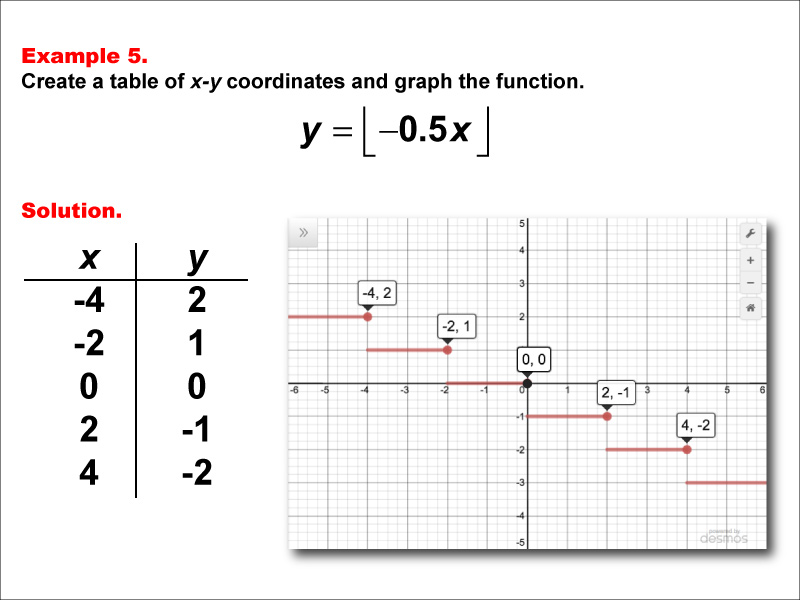
Display Title
Math Example--Special Functions--Step Functions in Tabular and Graph Form: Example 5
Display Title
Math Example--Special Functions--Step Functions in Tabular and Graph Form: Example 5

Topic
Special Functions
Description
This example showcases a step function defined by y = floor(-0.5x). The table includes x-values (-4, -2, 0, 2, 4) and corresponding y-values (2, 1, 0, -1, -2). The graph illustrates how this function behaves, with distinct horizontal segments that demonstrate the "stepping" nature of the function. This example helps students visualize how multiplying x by -0.5 inside the floor function affects the graph's appearance, particularly the width and direction of the steps.
Step functions are a fundamental concept in mathematics, especially in the study of special functions. This collection of examples aids in teaching the topic by providing visual representations of various step functions, allowing students to observe how different equations translate into graphical form. By examining both the table of coordinates and the corresponding graph, learners can develop a deeper understanding of how step functions behave and how modifications to the equation impact the resulting graph, including changes in step size, frequency, and direction.
Exposure to multiple worked-out examples is crucial for students to fully grasp the concept of step functions. Each example in this collection highlights different aspects of these functions, such as varying coefficients or additional terms within the floor function. By exploring a range of examples, students can identify patterns, make connections, and build a more comprehensive understanding of step functions and their applications in real-world scenarios, such as in economics, computer science, and signal processing.
Teacher's Script: Let's examine our fifth example, y = floor(-0.5x). Compare this to our previous examples, especially the last one. What do you notice about the direction and width of the steps? How has changing the sign of the coefficient affected the graph? Pay attention to how the y-values change as x increases. As we continue through more examples, try to predict how changes in both the magnitude and sign of the coefficient of x will influence the graph's appearance, particularly the frequency and direction of the steps.
For a complete collection of math examples related to Step Functions click on this link: Math Examples: Step Functions Collection.
| Common Core Standards | CCSS.MATH.CONTENT.HSF.IF.C.7, CCSS.MATH.CONTENT.HSF.IF.C.7.B |
|---|---|
| Grade Range | 9 - 12 |
| Curriculum Nodes |
Algebra • Functions and Relations • Special Functions |
| Copyright Year | 2015 |
| Keywords | function, step functions, graphs of step functions, step function tables, greatest integer function |